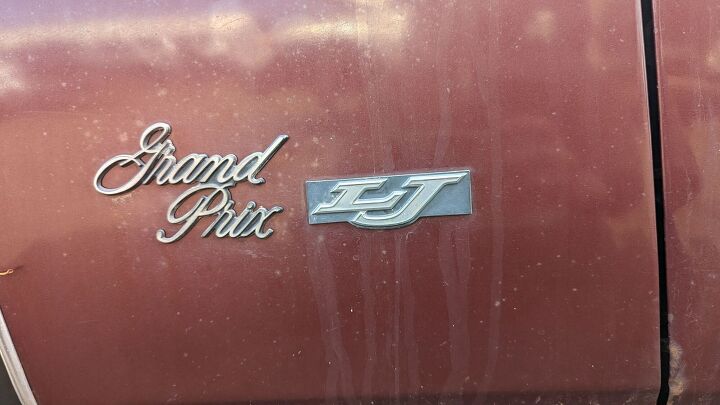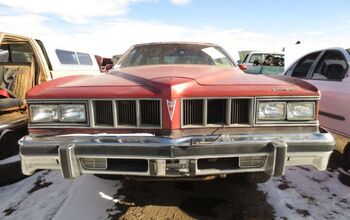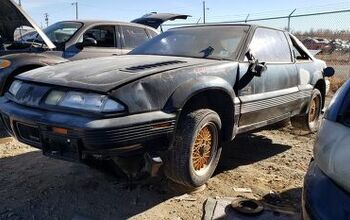Junkyard Find: 1976 Pontiac Grand Prix LJ

From the time John DeLorean and his Pontiac co-conspirators created the 1962 Grand Prix until the very last W-Body Grand Prix appeared a couple of years before Pontiac's demise, millions of North American car shoppers eagerly purchased the affordable sportiness of the Grand Prix. Today's Junkyard Find is an example from the very pinnacle of Grand Prix sales, found in pretty decent condition in a Colorado self-service wrecking yard.
The #1 and #2 all-time sales years for the Grand Prix were 1977 and 1976, respectively. 228,091 were sold for the 1976 model year. Throw in the even bigger sales for a couple of this car's A-Body siblings in 1976 (353,272 for the Chevrolet Monte Carlo, 385,578 for all two-door Oldsmobile Cutlass models) and you get a sense of the huge numbers of new A-Body coupes roaming the roads back then.
There were three trim levels for the 1976 Grand Prix: base, SJ and LJ. This is an LJ, which was the most luxurious Grand Prix available that year.
The LJ's price tag varied, depending on which paint and interior options were selected. This MSRP on this one (standard paint with 60/40 velour seating) would have been $5,568, or about $30,128 in 2023 dollars.
This was a lot of Bordello Red velour luxury for that kind of money, though we'll see that many costly options were purchased by this car's original buyer.
For example, this AM/FM/8-track stereo with built-in CB radio, which cost… well, I'm not sure. The AM/FM/8-track without CB was $337 (about $1,823 today), but this unit isn't listed in any of my reference books for 1976. It could be an aftermarket unit, or one swapped in from a later GM vehicle.
I thought about buying this one, but the microphone was missing (and I already have one from a slightly later Cadillac).
This thing is loaded, including power seats ($124, or $671 now).
Air conditioning ($505, or $2,732 today).
Power windows and locks ($99 and $62, or $536 and $335 after inflation).
The "Cordova landau top" came standard on the LJ. This one has been ravaged in the manner common to such tops that sit outdoors for long periods in High Plains Colorado.
The monogrammed quarter windows were standard equipment on all 1976 GPs.
This car appears to have the "Rally Gauges" package, which cost an extra $45 in the LJ ($243 in 2023 dollars).
As you can see from those preceding numbers, we are spoiled by all the standard features we get on even the cheapest new cars today.
Unusually for a midsize car from a low-prestige manufacturer in the middle-1970s, the 1976 Grand Prix came standard with an automatic transmission. Buyers of the closely related 1976 Pontiac LeMans got a three-speed column-shift manual transmission as base equipment.
The base engine in the 1976 Grand Prix LJ was a 400-cubic-inch (6.5-liter) Pontiac V8 with four-barrel carburetor, rated at 170 horsepower and 310 pound-feet.
For an extra $63 ($341 now), a Pontiac 455 (7.5-liter) V8 was available. That engine made 200 horses and 330 pound-feet, while providing single-digit gas mileage midway between the 1973 and 1979 Oil Crises.
The 400 wasn't much more economical, but so what? Not everyone was willing to drive a Corolla or Chevette in 1976. Just look at this car!
Chrysler (somewhat belatedly) recognized that the Grand Prix, Cutlass Supreme and Monte Carlo could be out-blinged, and so the even more rococo Cordoba hit the showrooms for the 1975 model year. Sales were brisk.
Performance wasn't great during the depths of the Malaise Era, but it was a golden age for strip-club-owner-grade luxury.
In fact, it's easy to picture Cosmo Vitelli driving a '76 Grand Prix (instead of his Cadillac) in " The Killing of a Chinese Bookie," which hit theaters in 1976.
This car is in good shape, with very little rust.
The interior needs very little beyond a cleaning. Some body and paint work would make this GP very nice.
Would a restoration of this car have been a wise investment? Maybe, though much nicer examples with even better options seem to argue against that idea.
For the 1978 model year, the GM A-Bodies got downsized. Grand Prix sales gradually declined after that, then picked up when the name moved over to the front-wheel-drive W Platform for 1988.
If you've been waiting since 1962 to be able to afford a Grand Prix, 1976 is your year!
Some say it's the most beautiful car in America.
[Images: Seller]
Become a TTAC insider. Get the latest news, features, TTAC takes, and everything else that gets to the truth about cars first by subscribing to our newsletter.

Murilee Martin is the pen name of Phil Greden, a writer who has lived in Minnesota, California, Georgia and (now) Colorado. He has toiled at copywriting, technical writing, junkmail writing, fiction writing and now automotive writing. He has owned many terrible vehicles and some good ones. He spends a great deal of time in self-service junkyards. These days, he writes for publications including Autoweek, Autoblog, Hagerty, The Truth About Cars and Capital One.
More by Murilee Martin
Latest Car Reviews
Read moreLatest Product Reviews
Read moreRecent Comments
- Ras815 It's insane they would go through all of that added expense and time to ship to Italy and back, all for noticeably inferior workmanship on their flagship product. A harbinger of GM's increasingly questionable decision-making, perhaps?
- ChristianWimmer US-spec 380SLs were especially asthmatic thanks to the emissions regulations. In Europe these were considered quite “quick” and powerful. They are slow cars by todays standards but excellent cruisers so this 380SL is perfect for someone who just wants a solid, open-top cruiser and not a weekend drag racer.IIRC the 560SL had a torque advantage over the European 500SL, but the 500SL was ultimately the quicker car.I own an ‘89 500SL R129 and despite the 326-horsepower torquey V8, it’s 0-100 km/h “performance” is held back by the 4-speed automatic and 2-ton weight. Even in their day these cars were not intended for drag racing or 0-100 km/h bragging times. They are cruisers meant to be enjoyed in a responsible manner. Plus, driving faster than 120-130 km/h with the top down or the soft top closed results in high wind noises for the former and a loud fluttering cloth top for the latter. As a result I drive a maximum of 110 km/h on the Autobahn with the top down or 120-130 km/h with the top up.
- Tassos more lipstick on the pitiful pig...
- Tassos While Summer officially starts w the Solstice around June 21-22, my summer has started on Monday May 6, when I started my ocean swimming season, a record early for me. Fortunately I think the water is warmer than in previous years (on Monday May 14, 2007, when I returned to my summer palace from a week's stay in Warsaw (the VIP treatment etc) I could not stand it, but did swim the next day May 15.
- Tassos I will wait for the more understated, if not eliminated, fins of the 60s and 70s. Form Follows Function unless there is really good reason, and I fail to see anything more than a passing fad here. Good Riddance, glad current Caddys are not as juvenile in their excellent styling (that Art and Science or Whatever theme has already lasted a quarter century and still looks better than Bangle-d BMWs.
























































Comments
Join the conversation
This breaks my heart. Ever since i was a kid in the 1970s I've always loved the 1976 GP because of that year's unique grill design. All of the late 1970s GM A-bodies were badass first cars for young guys in the early 1980s, especially the GP and the Cutlass. In Brooklyn and Queens where I grew up, those cars were (almost) the blue collar equivalent of BMW 3 Series.
do u still have have the ac compressor